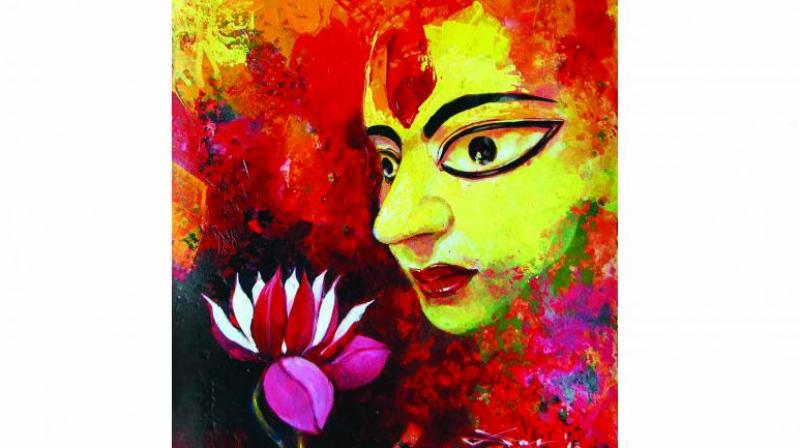The divine feminine

Navratri — nine nights celebration in full Sharad Navratri — is one of the major festivals held in honour of the divine feminine. Navratri celebration occurs during the month of Ashvin, usually September or October.
The killing of the demon Mahishasura and the war of nine days is celebrated as Navratri. The first three days Goddess Durga or Shakti is worshipped in the forms of Maheshwari, Koumari and Vaarahi. The next three days Goddess Lakshmi is worshipped in the forms of Mahalakashmi, Vaishnavi and Indrani. The last three days Goddess Saraswati is worshipped in the forms of Naraasimhi, Chamundi and Saraswati.
The core Hindu mythological reason behind the festival remains the same — the victory of good over evil. In the Eastern and Northeastern states of India, the celebration is referred to as Durga Puja. It is believed that Durga fought with Mahishasura and emerged victorious. Post which, the day was marked to honour the divine and celebrated as Durga Puja. It symbolises the end of the period of Shradhh or Pitri-Paksha.
In North India, Navratri is defined as Nav meaning nine and ratri meaning nights — a nine-night festival that is celebrated as the the victory of Rama over Ravana. The story of Lord Rama is enacted for nine days which is called Ramlila and on the last day, when Rama kills Ravana with his bow, the festival is ended by burning effigies of Ravana and his brothers Meghnad and Kumbhakaran.
Colours are a unique part of Indian festivals. Navratri is celebrated with nine specific colours. The festival celebrates the nine avatars of Durga, and each form is represented by a specific, symbolic colour of her attire. People dress up in colours matching the attire of the idol on that day.
On the first day, the goddess of knowledge Saraswati is worshipped and her colour is yellow, followed by Goddess Jagadamba, who blesses us with compassion and her colour is green. On the third day, Goddess Bhairavi is worshipped who fulfills devotees’ wishes and her colour is grey. On the fourth day Goddess Chamunda is worshipped, she stands for courage and her colour is orange, followed by Parvati, who has all the qualities of a Devi and her colour is white. The sixth day Goddess Durga is worshipped and red is her colour which protects us from evil. On the seventh day, Goddess Renuka is worshipped, who is a source of inspiration for humans and her colour is royal blue. Eighth day is the day of Goddess Maha Gauri who calmly forgives her devotees’ sins, her colour is pink. On the last day, Goddess Kushmanda who signifies a fresh start is worshipped, her colour is lavender/purple.
During Navratri, we worship the feminine in the form of Goddess and on the ninth day a ritual of ‘Kumari Puja’ takes place. The festival of Shakti also teaches us to respect females in all forms of life.
Woman is Shakti and to respect her means respecting the Goddess. There is a saying: ‘Yatra naryastu pujyante ramante tatra devta’, which means that where women are respected, Goddess Lakshmi blesses that home.

